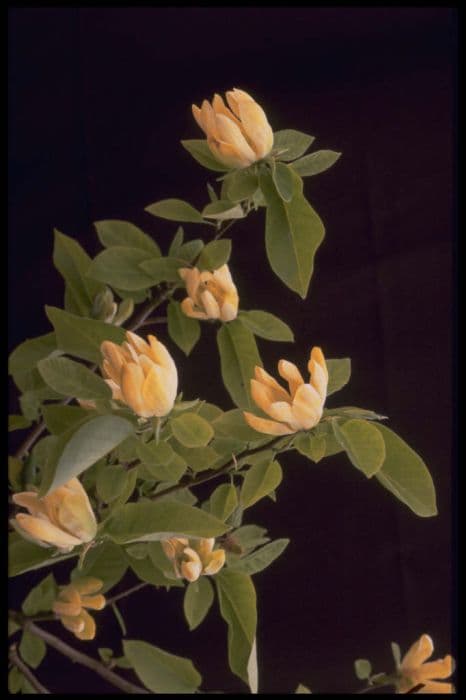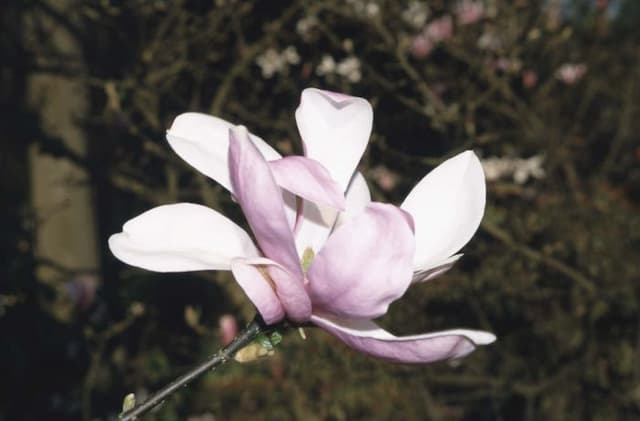Susan Magnolia Magnolia 'Susan'

ABOUT
Magnolia 'Susan' is a captivating deciduous shrub known for its striking floral display. This plant typically produces an abundance of elongated, goblet-shaped flowers. The blooms exhibit a rich, deep pink hue on the outside with a paler, more subtle pink inside, providing a delightful two-tone effect. The flowers emerge from sleek, velvety buds and are known for their somewhat late appearance in spring, which protects them from the early frosts that can damage early blooming magnolias. The leaves of Magnolia 'Susan' are oblong and lush green, providing a beautiful backdrop for the flowers. After the flowering season, the foliage remains attractive throughout the summer until it turns to a warm, golden yellow color in the fall, marking the transition to dormancy. The plant's overall shape is often described as compact and bushy, with gracefully spreading branches that give it a rounded appearance. The bark is smooth and silvery-gray, providing a subtle contrast to the dark green leaves. This magnolia's blooms are also known for their fragrant scent, which can enhance the sensory appeal of gardens. The fragrance is sweet and can be quite pervasive in the surrounding area, especially on warm, sunlit days. The flowers of Magnolia 'Susan' are not only visually appealing but also serve as a source of nectar for pollinators such as bees, thus contributing to the ecosystem. Overall, Magnolia 'Susan' is celebrated for its exceptional bloom and elegant form, making it a prized specimen in many temperate ornamental gardens.
About this plant
 Names
NamesFamily
Magnoliaceae
Synonyms
Susan Magnolia, Magnolia Susan
Common names
Magnolia 'Susan'.
 Toxicity
ToxicityTo humans
The Magnolia 'Susan' is considered non-toxic to humans. In general, magnolias are not known to possess any toxic principles that would cause harm upon ingestion. However, individual sensitivity can vary, and consumption of non-food plants is generally discouraged due to potential for gastrointestinal discomfort or allergic reactions.
To pets
Magnolia 'Susan', commonly referred to as simply Magnolia, is not listed as toxic to pets by the ASPCA or other major animal poison control resources. It is generally considered safe for cats, dogs, and other animals, and there should be no toxic effects if pets ingest parts of this plant. However, as with humans, overconsumption can potentially lead to mild stomach upset or an allergic reaction in some pets.
 Characteristics
CharacteristicsLife cycle
Perennials
Foliage type
Deciduous
Color of leaves
Green
Flower color
Pink
Height
8-12 feet (2.4-3.7 meters)
Spread
6-9 feet (1.8-2.7 meters)
Plant type
Shrub
Hardiness zones
4-9
Native area
North America
Benefits
 General Benefits
General Benefits- Aesthetic Appeal: Susan magnolia offers stunning purple-pink flowers in the spring that can significantly enhance the visual appeal of gardens and landscapes.
- Fragrance: The blossoms emit a pleasant fragrance that can add a sensory dimension to garden spaces.
- Wildlife Attraction: The flowers attract pollinators like bees and butterflies, which can help pollinate other plants in the garden.
- Compact Size: As a smaller magnolia, it is suitable for urban gardens or areas with limited space.
- Seasonal Interest: Provides year-round interest with flowers in spring, lush green leaves in summer, and sometimes attractive seed pods in autumn.
- Low Maintenance: Requires minimal pruning and care once established, making it a convenient choice for busy gardeners.
- Durability: It is relatively hardy and can withstand cold temperatures better than some other magnolia varieties.
- Versatility: Suitable for a variety of landscape uses, including as a specimen plant, in mixed borders, or as a foundation planting.
 Medical Properties
Medical PropertiesThis plant is not used for medical purposes.
 Air-purifying Qualities
Air-purifying QualitiesThis plant is not specifically known for air purifying qualities.
 Other Uses
Other Uses- Magnolia 'Susan' petals can be pickled and used in salads for a tangy flavor or as a unique garnish for various dishes.
- The bark of Magnolia 'Susan' has been used in the art of natural dyeing, providing colors ranging from green to brown.
- Wood from the Magnolia 'Susan' tree can be carved into small decorative items or utensils, offering a use for pruned or fallen branches.
- Leaves from the Magnolia 'Susan' can serve as a natural mulch, providing nutrients to the soil as they decompose.
- The flower buds can be candied and used as sweet decorations for desserts and cakes.
- Magnolia 'Susan' cones can be used in craft projects, such as making wreaths or as components in floral arrangements.
- When dried, the leaves can be incorporated into homemade potpourri mixes, adding a subtle fragrance to a room.
- Seed pods from Magnolia 'Susan' can be used in educational settings to teach children about plant life cycles and seed dispersal.
- Petals of the Magnolia 'Susan' can be pressed and used in botanical paper making, creating unique textures and patterns.
- The wood of Magnolia 'Susan' can be used in small-scale woodworking projects, like making picture frames or jewelry boxes.
Interesting Facts
 Feng Shui
Feng ShuiThe Magnolia is often associated with purity and nobility in Feng Shui; its large, showy flowers can bring a calming and beautifying energy to a garden. To use it in accordance with Feng Shui principles, plant the Magnolia in the Southeast sector of your garden to attract wealth or in the Southwest sector to enhance relationships and love, as it can foster a romantic and blissful energy.
 Zodiac Sign Compitability
Zodiac Sign CompitabilityThe Magnolia is not used in astrology practice.
 Plant Symbolism
Plant Symbolism- Perseverance and Endurance: Magnolias are known for their ability to withstand harsh climates, hence symbolizing strength and the ability to persevere through difficult conditions.
- Nobility and Dignity: Because of their grand and impressive blooms, magnolias are often associated with royalty and elegance.
- Feminine beauty: The Magnolia Susan, with its delicate and graceful flowers, often represents purity and the refined beauty of women.
- Welcome: In the South, magnolias are a sign of hospitality. The lush flowers express a warm and inviting sentiment.
- Love for nature: As a plant that is often found in natural settings, Magnolia Susan stands as a symbol of an individual’s love and appreciation for nature and the great outdoors.
 Water
WaterSusan Magnolias require regular watering to maintain moist, well-drained soil, especially during their first few years after planting to establish a strong root system. They do not tolerate drought well, so during dry periods, it's important to water them thoroughly. On average, water your Susan Magnolia with about 1 to 1.5 gallons per week, but this can vary depending on climate conditions. In hot, dry weather, you may need to water twice a week, ensuring that the soil is moist but not waterlogged. During the winter or in cooler climates, reduce the frequency to match the plant's reduced water needs.
 Light
LightSusan Magnolias thrive best in full sun to partial shade conditions. They should be planted in a spot that receives at least four hours of direct sunlight daily, but they can also benefit from some dappled shade during the hottest part of the day. The ideal location would protect them from harsh afternoon sun while providing bright morning light, which encourages healthy growth and optimal flowering.
 Temperature
TemperatureSusan Magnolias are hardy to USDA zones 4 through 9, which means they can tolerate a range of temperatures. Ideally, they flourish in temperatures between 70°F to 85°F during the growing season. They can survive minimum winter temperatures down to about -30°F and should not be exposed to temperatures above 95°F for extended periods, as this can stress the plant.
 Pruning
PruningPrune Susan Magnolias to shape the tree, remove any dead or broken branches, and promote healthier growth. The best time to prune is soon after the plant finishes blooming in late spring or early summer. Pruning at this time minimizes the impact on flowering, as Susan Magnolias produce buds on old wood. Maintenance pruning should be done sparingly to maintain the natural form of the tree.
 Cleaning
CleaningAs needed
 Soil
SoilThe best soil mix for Susan Magnolia should be rich, organic, and well-draining with a slightly acidic to neutral pH ranging from 5.5 to 7.0. Amend garden soil with compost and peat moss to achieve these conditions for optimal plant health and blooming.
 Repotting
RepottingSusan Magnolia, being a larger shrub or small tree, does not require frequent repotting and can be done every 3 to 5 years or when it is significantly root-bound. Young plants may need repotting more frequently to encourage growth.
 Humidity & Misting
Humidity & MistingSusan Magnolia thrives in moderate to high humidity conditions but is quite adaptable and does not require specific humidity levels to prosper. It will benefit from the natural humidity present in most outdoor environments without the need for intervention.
 Suitable locations
Suitable locationsIndoor
Place Susan Magnolia near a window, ensure bright indirect light.
Outdoor
Plant in well-draining soil, full sun to partial shade.
Hardiness zone
4-9 USDA
 Life cycle
Life cycleThe life of a Magnolia 'Susan' begins with seed germination, typically in spring or summer, where the seed must experience a period of cold stratification to break dormancy. Following germination, the seedling stage is characterized by the development of a root system and the first set of true leaves, which will photosynthesize to fuel further growth. The juvenile stage sees the magnolia rapidly growing in size and stature, forming a woody stem and branches, but not yet flowering. As it enters maturity, the Magnolia 'Susan' starts to produce its signature fragrant, purple-pink, goblet-shaped flowers, usually from mid-spring to early summer, which are pollinated by insects, leading to seed development. The mature stage is marked by a balance of vegetative growth and annual flowering cycles, with the plant capable of living for several decades. Finally, as the plant comes to the end of its life cycle, growth slows, and it becomes more susceptible to environmental stresses and diseases, eventually leading to senescence and death.
 Propogation
PropogationPropogation time
Spring-Early Summer
Magnolia 'Susan' can be most commonly propagated through softwood cuttings, typically done in late spring to early summer when the new growth is still flexible but has begun to mature. To propagate by cutting, take a healthy shoot of about 4 to 6 inches (10 to 15 cm) long, making sure it includes at least two sets of leaves. Dip the cut end in rooting hormone to encourage root growth and plant it in a pot filled with a mixture of peat and perlite or a well-draining potting mix. The cutting should be kept in a humid environment with indirect light and consistent moisture. Roots usually develop within a few weeks to a couple of months, after which the new Magnolia 'Susan' can eventually be transplanted outdoors.


![Magnolia [Fairy Blush]](/_next/image?url=https%3A%2F%2Fplants-admin.emdemapps.com%2Fimages%2Fplants%2F%2Fimages%2F604b5a108e959.png&w=640&q=75)






![Magnolia [Black Tulip]](/_next/image?url=https%3A%2F%2Fplants-admin.emdemapps.com%2Fimages%2Fplants%2F%2Fimages%2F604b590290fc7.png&w=640&q=75)